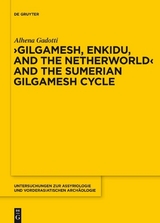Gilgamesh, Enkidu, and the Netherworld and the Sumerian Gilgamesh Cycle
Seiten
In den Bänden der Reihe werden Themen aus der Philologie der Keilschriftsprachen (Sumerisch, Akkadisch, Hethitisch, Hurritisch, Elamisch u. a.), der altorientalischen Geschichte sowie der vorderasiatischen Archäologie und Kunstgeschichte behandelt. Der geographische Rahmen umfasst primär Mesopotamien, Nordsyrien, Anatolien, Altarmenien und Elam sowie sekundär weitere Gebiete, die in engem Kontakt mit den Keilschriftkulturen stehen. Im Zentrum steht der Zeitraum vom vierten bis zum ersten Jahrtausend v. Chr.
Alhena Gadotti offers a much needed new edition of the Sumerian composition Gilgamesh, Enkidu, and the Netherworld, last published by Aaron Shaffer in his 1963 doctoral dissertation. Since then, several new manuscripts have come to light, prompting not only a new edition of the text, but also a re-examination of the composition. In this book, Gadotti argues that Gilgamesh, Enkidu, and the Netherworld was the first, not the last of the Sumerian stories about Gilgamesh. She also suggests that a Sumerian Gilgamesh Cycle, currently only attested in old Babylonian manuscripts (ca. 18th century BCE), was in fact developed during the Ur III period (ca. 2100-2000 BCE). Providing a new way to look at the Sumerian Gilgamesh stories, this book is relevant not only to scholars of the ancient Near East, but also to anyone interested in epic and epic cycle.
Alhena Gadotti offers a much needed new edition of the Sumerian composition Gilgamesh, Enkidu, and the Netherworld, last published by Aaron Shaffer in his 1963 doctoral dissertation. Since then, several new manuscripts have come to light, prompting not only a new edition of the text, but also a re-examination of the composition. In this book, Gadotti argues that Gilgamesh, Enkidu, and the Netherworld was the first, not the last of the Sumerian stories about Gilgamesh. She also suggests that a Sumerian Gilgamesh Cycle, currently only attested in old Babylonian manuscripts (ca. 18th century BCE), was in fact developed during the Ur III period (ca. 2100-2000 BCE). Providing a new way to look at the Sumerian Gilgamesh stories, this book is relevant not only to scholars of the ancient Near East, but also to anyone interested in epic and epic cycle.
Alhena Gadotti, Towson University, Towson, MD, USA.
| Erscheint lt. Verlag | 16.6.2014 |
|---|---|
| Reihe/Serie | Untersuchungen zur Assyriologie und vorderasiatischen Archäologie ; 10 |
| Zusatzinfo | 213 Illustrations, black and white |
| Verlagsort | New York |
| Sprache | englisch |
| Maße | 210 x 280 mm |
| Gewicht | 1405 g |
| Themenwelt | Geisteswissenschaften ► Archäologie |
| Geschichte ► Allgemeine Geschichte ► Vor- und Frühgeschichte | |
| Geschichte ► Allgemeine Geschichte ► Altertum / Antike | |
| Geschichte ► Hilfswissenschaften ► Paläografie | |
| Geisteswissenschaften ► Geschichte ► Regional- / Ländergeschichte | |
| Geisteswissenschaften ► Sprach- / Literaturwissenschaft ► Anglistik / Amerikanistik | |
| Geisteswissenschaften ► Sprach- / Literaturwissenschaft ► Literaturwissenschaft | |
| Schlagworte | Gilgamesch • Gilgamesh; Sumerian literature; Mesopotamian literature; Ancient Near Eastern epic • Sumerer |
| ISBN-10 | 1-61451-708-8 / 1614517088 |
| ISBN-13 | 978-1-61451-708-5 / 9781614517085 |
| Zustand | Neuware |
| Haben Sie eine Frage zum Produkt? |
Mehr entdecken
aus dem Bereich
aus dem Bereich
auf den Spuren der frühen Zivilisationen
Buch | Hardcover (2023)
C.H.Beck (Verlag)
20,00 €
Konzepte – Methoden – Theorien
Buch | Softcover (2024)
UTB (Verlag)
39,90 €
Was Pompeji über uns erzählt
Buch | Hardcover (2023)
Propyläen (Verlag)
32,00 €




